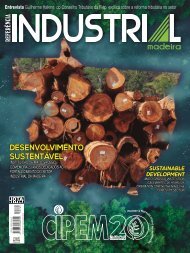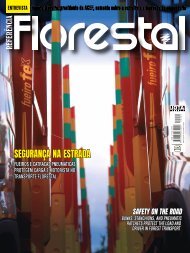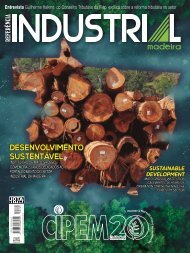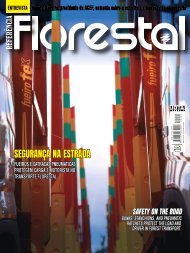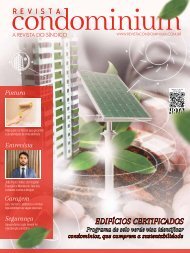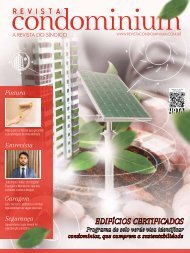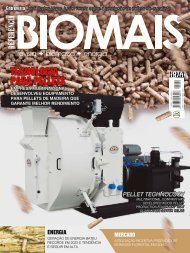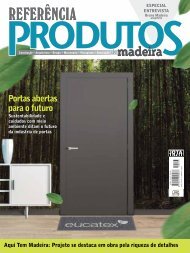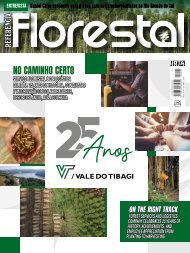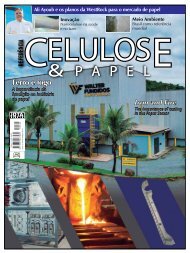Create successful ePaper yourself
Turn your PDF publications into a flip-book with our unique Google optimized e-Paper software.
Na saúde<br />
Um curativo de nanocelulose que pode revelar<br />
sinais precoces de infecção, sem interferir<br />
no processo de cicatrização, foi desenvolvido<br />
por pesquisadores da Universidade de Linköping,<br />
na Suécia. O estudo deles, publicado<br />
na Materials Today Bio, é mais um passo no<br />
caminho para um novo tipo de tratamento de<br />
feridas.<br />
A pele é o maior órgão do corpo humano.<br />
Uma ferida perturba o funcionamento normal<br />
da pele e pode demorar muito tempo a<br />
cicatrizar, ser muito dolorosa para o paciente e<br />
pode – na pior das hipóteses – levar à morte se<br />
não for tratada corretamente. Além disso, as feridas<br />
difíceis de curar representam um grande<br />
fardo para a sociedade, representando cerca<br />
de metade de todos os custos dos cuidados<br />
ambulatórios.<br />
No tratamento tradicional de feridas, os<br />
curativos são trocados regularmente, aproximadamente<br />
a cada dois dias. Para verificar se<br />
a ferida está infectada, a equipe médica deve<br />
levantar o curativo e fazer uma avaliação com<br />
base na aparência e nos exames. Este é um<br />
procedimento doloroso que perturba a cicatrização<br />
da ferida, pois a crosta se rompe repetidamente.<br />
O risco de infecção também aumenta<br />
cada vez que a ferida é exposta.<br />
Pesquisadores da Universidade de Linköping,<br />
em colaboração com colegas das Universidades<br />
de Örebro e Luleå, desenvolveram<br />
agora um curativo feito de nanocelulose que<br />
pode revelar sinais precoces de infecção sem<br />
interferir no processo de cicatrização. Daniel<br />
Aili, professor da Divisão de Biofísica e Bioengenharia<br />
da Universidade de Linköping,<br />
destaca que esse curativo pode facilitar muito<br />
o trabalho de médicos ao redor do mundo.<br />
“Ser capaz de ver instantaneamente se uma<br />
ferida infeccionou, sem ter que levantar o<br />
curativo, abre um novo tipo de tratamento de<br />
feridas que pode levar a cuidados mais eficientes<br />
e melhorar a vida de pacientes com feridas<br />
difíceis de curar. também pode reduzir o uso<br />
desnecessário de antibióticos”, destaca Daniel.<br />
In health<br />
A nanocellulose dressing that can detect early signs of infection<br />
without interfering with the healing process has been developed<br />
by scientists at Linköping University in Sweden. Their study,<br />
published in Materials Today Bio, is another step towards a new<br />
type of wound treatment.<br />
The skin is the largest organ in the human body. A wound<br />
disrupts the normal function of the skin, can take a long time to<br />
heal, can be very painful for the patient, and, in the worst cases,<br />
can lead to death if not treated properly. In addition, hard-to-heal<br />
wounds are a major burden on society, accounting for approximately<br />
half of all outpatient care costs.<br />
Traditional wound care involves changing dressings regularly,<br />
approximately every two days. To check for infection, the healthcare<br />
team must lift the dressing and make an assessment based<br />
on appearance and examination. This painful procedure interferes<br />
with wound healing as the scab breaks off repeatedly. The risk of<br />
infection also increases each time the wound is exposed.<br />
Scientists at Linköping University, in collaboration with colleagues<br />
at Örebro and Luleå Universities, have now developed<br />
a nanocellulose dressing that can detect early signs of infection<br />
without interfering with the healing process. Daniel Aili, a<br />
Professor at the Department of Biophysics and Bioengineering at<br />
Linköping University, points out that this dressing could make the<br />
work of doctors around the world much easier. “The ability to<br />
immediately see if a wound has become infected, without having<br />
to lift the dressing, opens up a new way of treating wounds that<br />
could lead to more efficient care and improve the lives of patients<br />
with hard-to-heal wounds. It could also reduce the unnecessary<br />
use of antibiotics,” says Aili.<br />
Foto: ilustrativa<br />
31



